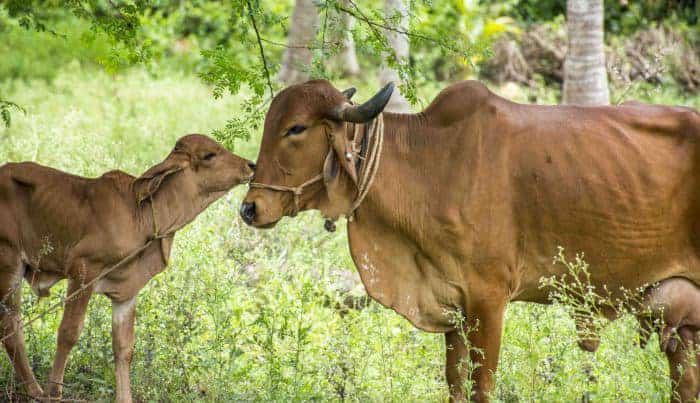
The Indian Cattle Breed Behind the White Revolution in Brazil
The total cattle population in India is 192.49 Million in 2019, witnessing an increase of 0.8 per cent over previous Livestock Census of 2012. About 36 per cent of the total livestock is contributed by cattle in India. The female cattle population has increased by 18.0 per cent, and male cattle decreased by 30.2 per cent over the previous census.

India is the leading milk-producing country in the world, accounting for 20 per cent of the global market share where dairying is considered a major source of livelihood for farmers particularly in the times of agrarian distress. There has been a major thrust by the government to boost milk production by supporting programmes for increasing milk productivity, input suppliers and access to organised milk processing sector.
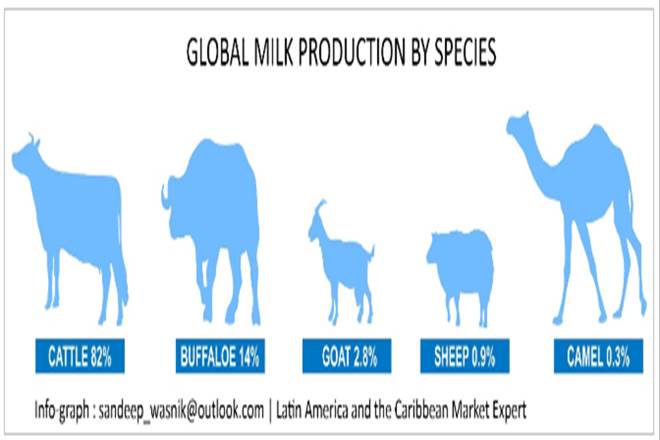
The milk processing industry in India is expected to expand at a compound annual growth rate (CAGR) of nearly 14.8 per cent between FY 2018 and FY 2023 and will touch Rs 2,458.7 billion in FY 2023. On the other hand, Brazil has had an average growth of 7 per cent in world milk production, which has led the country to occupy the fifth position in terms of volume. Maharaja of Bhavnagar, Gujarat, Krishna Kumarsinhji Bhavsinhji and first Indian Governor of Madras was instrumental in changing the fortunes of the Brazilian dairy industry.
In the 18th century, Maharaja gifted a Gir cattle pair to Celso Garcia Cid, an icon in the history of Brazilian livestock and successful entrepreneur. This breed is famous for its down horns and reddish-white coat. The bull gifted was named ‘Krishna’, after one of the most popular Hindu gods worshipped in India.

When Krishna was brought to Brazil in 1960, it started a genetic revolution that made ‘Gir one of the most valued breeds in the bovine embryo market and spawned a mixed breed. It is estimated that 80 per cent of Brazilian ‘Gir’ cattle carry genes from the ‘Krishna’ bull that is now referred to as ‘Gyr’. The ‘Gyr’ was subsequently crossbred with Holstein, a Dutch variety, to create the hybrid ‘Girolando’. This breed grew rapidly across Brazil and contributed to about 80 per cent of the nation’s milk production and was registered officially in 1989 by Brazil’s agriculture ministry.
Gir cows which brought a white revolution in Brazil, has over the years, become a high milk-yielding breed and is quite popular in South American countries due to its ability to survive in extreme weather and tropical diseases.

Brazil now has about 40 lakh heads of ‘Gir’ cattle and a well-cared-for ‘Gir’ cow is capable of yielding an average of 30 to 40 litres of milk a day, and this can even go up to 60 to 70 litres. This huge amount of milk contributes to the Brazilian economy.
In recognition of the Gir’s role in the country’s economy, it finds a place on Brazil’s coins and in recognition of Maharaja Krishna Kumarsinhji Bhavsinhji’s contribution to its dairy industry; the country has erected a statue of the late ruler near its Parliament House. Over time, this breed has now spread across the American continent and the Gir cow is one of the principal ‘Zebu’ breeds of cattle that originated in India.
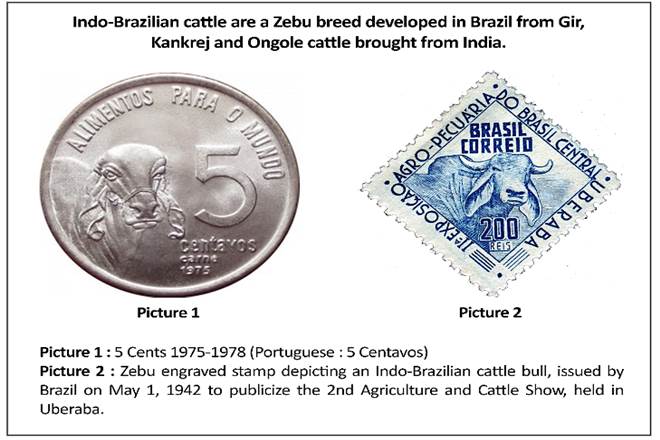
Another breed ‘Ongole’ strain from Andhra Pradesh led to the production of the ‘Zebu’ variety is known in Brazil as ‘Nelore’. Collaboration between India and Brazil for cattle genomics is already on the ground now. The Telangana government has decided to create its own proto-type of Zebu with the objective of improving the milk production of Indian cattle. Brazil still imports fresh embryos from India to rejuvenate its cattle breed.
In 2016, India and Brazil signed MOU between the Department of Animal Husbandry, Dairying & Fisheries (DADF) and Brazilian Agriculture Research Corporation (EMBRAPA) on cooperation in the Fields of Zebu Cattle Genomics and Assisted Reproductive Technologies. The Brazilian government has agreed to set up an Indo-Brazil Centre of Excellence for Cattle and Sheep Breeding, research and development facility, at Nizamabad as part of the Gopal Gram scheme, where it will provide technical expertise and also train officials. The ‘Gokul Gram’ scheme works towards the conservation and development of native cattle breeds.
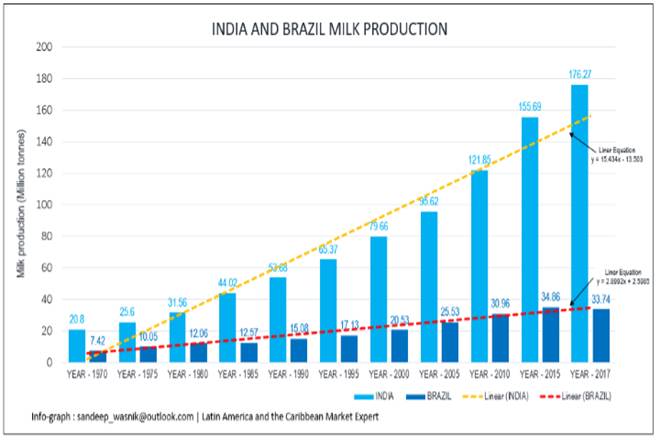
In 2018, India signed an MoU with Brazil for one lakh doses of frozen Gir bull semen for artificial insemination to increase the indigenous breed’s yield. However, cow breeders in India are up in arms against the proposed import of one lakh semen doses from Brazil to produce Gir breed of cows as they feel it would affect the purity of the native breed in the country and affect dairy farmers adversely.
The South and South-eastern regions of Brazil are the main milk-producing areas with Minas Gerais being the largest milk-producing state, accounting for 25 per cent of total milk production in 2018. Last year, Rio Grande do Sul accounted for 14 per cent and Paraná accounted for 13 per cent, which is an increase of two per cent from 2017. Average milk production in Brazil was 27.9 litres/cow/day in 2018, an increase of 3.2 per cent compared to the previous year.
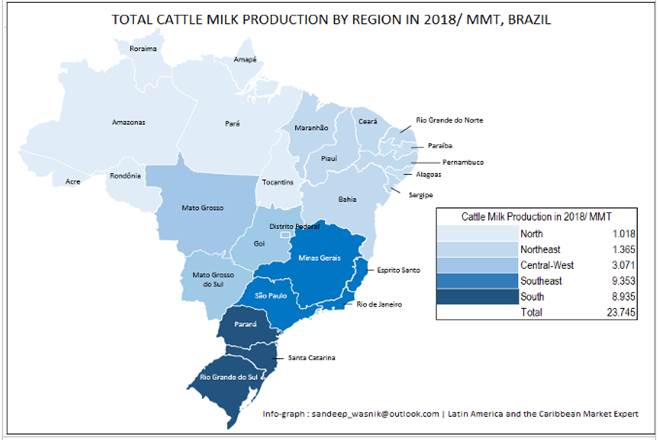
The Brazilian Ministry of Agriculture initiated a Dairy Goat Breeding Plan in 2005, with Livestock and Food and the Association of Goats and Sheep Breeders of Minas Gerais. In testing more than 20 herds with Saanen, Alpine and Nubian bucks, the average total milk yield in a complete lactation was 768 kg, the 305 days milk yield was 676 kg, the lactation length was 278 days and the daily yield was 2.75 kg/d from a total of approximately 8,000 tests. The climatic variables were the strongest contributions to the differences in dairy goat production between regions of Brazil.
On the other hand, In India, nearly 4 per cent of milk contributed from goat and Rajasthan is the leading state (BAHS, 2014). At present scenario, India stands first in goat milk production and second in goat meat production in the world. In-country, ICAR- National Bureau of Animal Genetic Resources- the nodal agency for breed registration in India has registered 26 breeds of Goat.
Out of these, the high genetic merit (more meat “chevon”, milk and fibre production) indigenous registered breeds exist are only 12 breeds. Black Bengal, Osmanabadi, Barbari and Kannaiadu goat breeds are excellent in chevon quality and production. The major milk-producing goat breeds are Jamunapari, Beetal, Jakhrana and Surti while Changthangi, Chegu and Gaddi have good potential for fibre/pashmina production. Total Goat Population in the country is 148.88 Million during 2019, which is increased by 10.14 per cent over previous Livestock Census 2012 and about 27.8 per cent of the total livestock is contributed by goats.
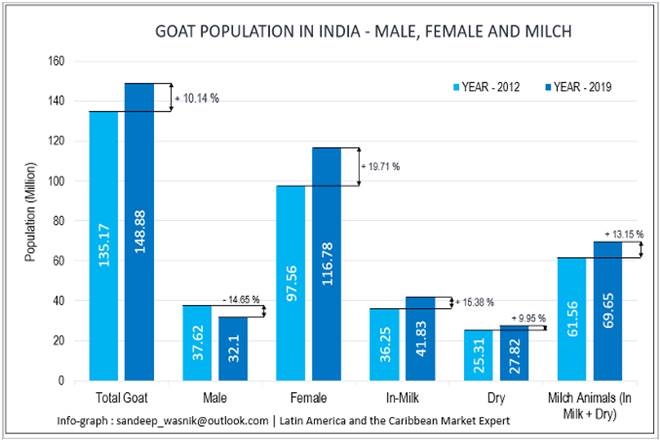
Both countries can adopt Breeding Strategies for improving goat milk production is an important factor and formulating the breeding strategy for goat improvement, the formulators should have the criteria, like the adaptability of the breeds in the local agro-climatic conditions, the Socio-economic condition of the farmer, Availability of good quality bucks, Conservation of indigenous recognised breeds by preventing them from rampant genetic dilution. In India exotic breeds like Alpine, Sannen have been used with the indigenous breed to improve their milk production.
The selective breeding and crossbreeding can be adopted based on the need of the locality, demand for the market, traits under consideration. Milk yield traits are medium to high heritable in nature, response to selection will be better. Performance recording and progeny testing programs should be encouraged to select and propagate elite bucks. Nucleus flocks/herds can be established with best performing females and their male progenies and can be linked with farmers flock. Artificial insemination with liquid and preferably frozen semen may be adopted to make the progeny testing programmed more effective.
(The author is Latin America and the Caribbean Countries Market Expert. Views expressed are personal.)
Source: The article is extracted from Financial Express, December 13, 2019.
